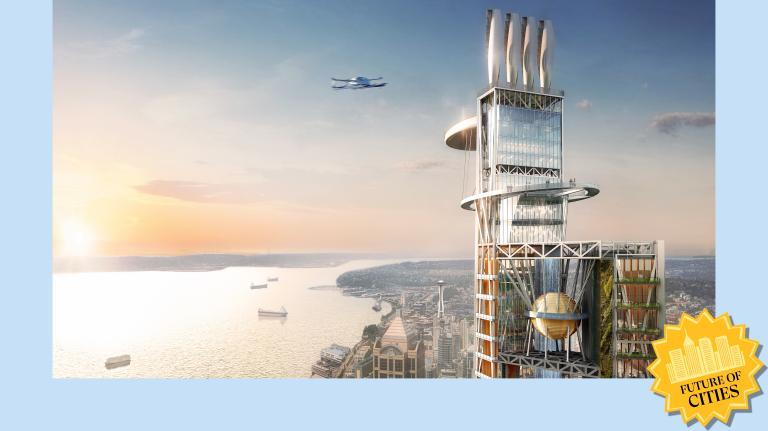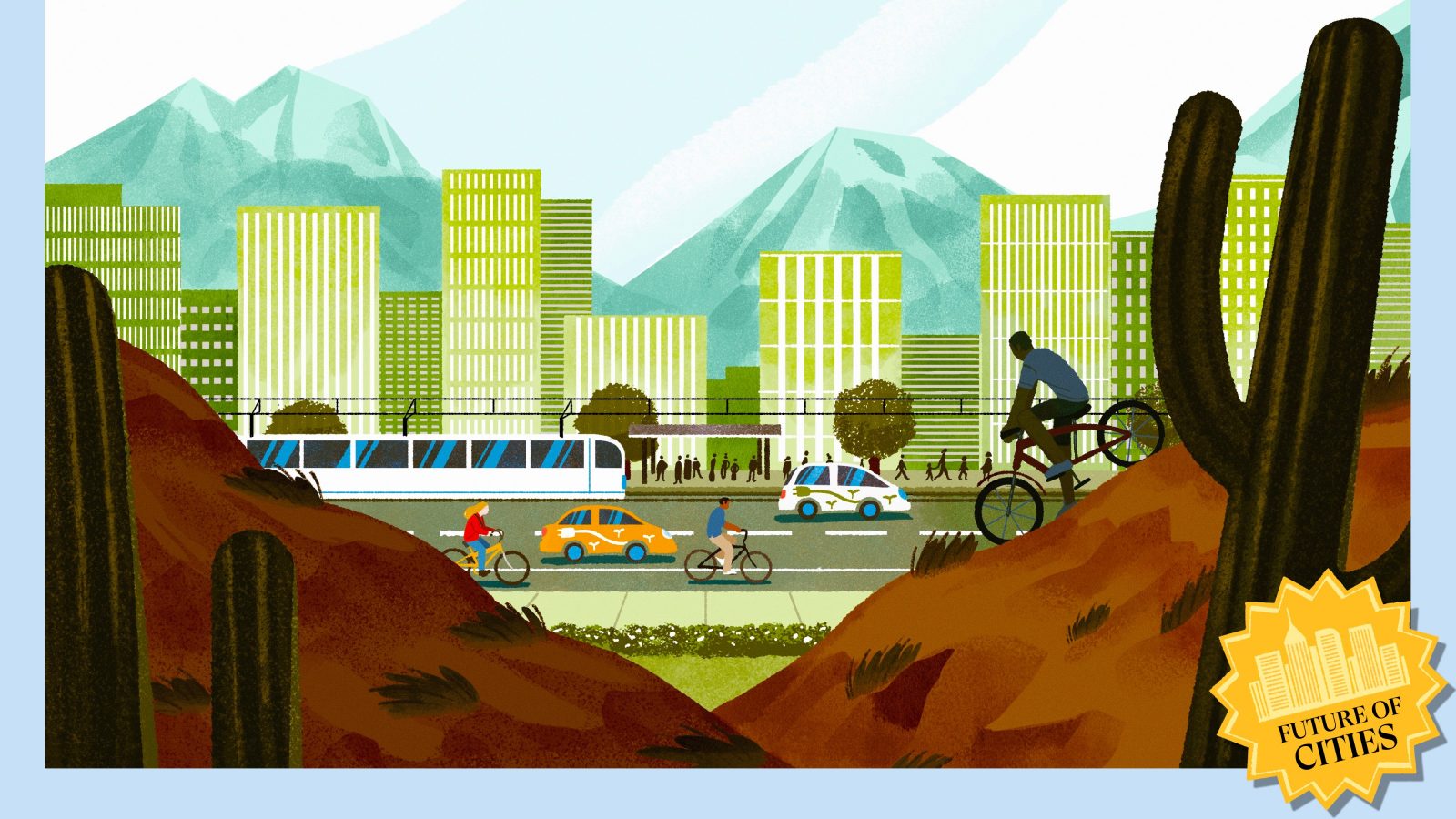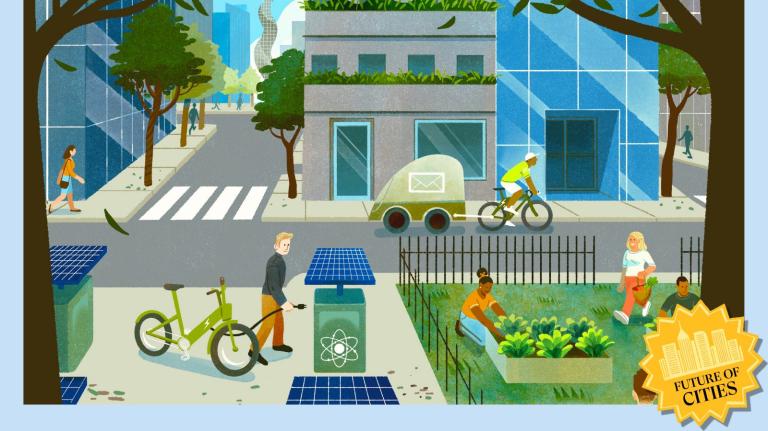As the climate changes, cities must change with it. Fix is exploring how our urban centers are being reimagined and what green, equitable, and resilient communities could look like. With insights from local officials, architects, residents, and more, our Sustainable Cities of the Future series examines how we’ll live, work, and play in the cities of tomorrow. (Explore the full series so far.)
Yassamin Ansari has played a role in some of the biggest climate initiatives of the past decade. As an advisor to U.N. Secretary General Ban Ki-moon, she spent a year working on the Paris Agreement (yes, that Paris Agreement). She later coordinated the first U.N. Youth Climate Summit. In between, she directed a handful of global climate action summits and persuaded more than 20 big tech companies like Slack and Salesforce to sign on to decarbonization goals through the Step Up Declaration. All that green cred landed her on the Grist 50, Fix’s annual list of up-and-coming changemakers, in 2019. But since then, Ansari has zeroed in on a different front for battling the climate crisis: local government.
This spring, Ansari stepped into a new role as city councilor for her hometown of Phoenix, becoming the youngest woman ever elected to that office. It’s a big pivot, she says, but the shift from macro to micro felt like the best way to make change happen in a tangible way. “I loved my experience at the U.N.,” she says, “but I was at the point where I thought I could have a bigger impact at the local level.” After all, the big global and national targets mean little if cities, towns, and counties don’t actually do the work to meet them.
[Who’s building the green cities of the future? These 5 people — and a whole lot of others.]
Although Phoenix is the fifth largest city in the country, Ansari sees it as an up-and-coming place — diverse, growing, and full of potential. The desert metropolis was once known as the least sustainable city on the planet, but she and her colleagues are committed to turning that reputation on its head and making Phoenix a model for other cities around the world.
We caught up with Ansari to ask about her new job and what she hopes to achieve in her first term. Her responses have been edited for length and clarity.
Q. You’ve probably heard this question a lot, but what made you want to run for city council in Phoenix?
A. I have heard this question a lot. I worked in the climate space for about six years after I graduated from college. I worked on the U.N. secretary general’s climate team that helped deliver the Paris Agreement. I worked on a couple of big climate summits in D.C., New York, and California, and had the opportunity to work with cities, states, and companies on their emissions-reduction targets, pushing them to set bold climate plans.
That’s when I really became passionate about city government in particular and the role that I think cities can play in combating the climate crisis. I’m from Phoenix. I grew up here. I started exploring what Phoenix has done in the past, and I discovered [that] until a couple of years ago, we were literally known as one of the least sustainable cities in the country. We’re very much on the front lines of the climate crisis, whether you look at extreme heat, drought, wildfire threats, or air pollution. But not enough was being done about it. I decided to run for city council to be the champion for this issue.
Q. What was it like shifting from the global level to local politics?
A. [At] these climate summits that I worked on, the entire purpose was to push cities around the U.S. and the world to make commitments to renewable energy policies, transportation policies, EVs, etc. I honestly got tired of being in the position of trying to persuade other people to take the climate crisis seriously. I realized that it really can be one person or two people leading within a local elected body that can change things.
Help us imagine the sustainable cities of the future. We want to hear what you’re seeing today that’s exciting, or your biggest ideas for the future.
When it comes to Phoenix, we’re now the fifth largest, and fastest growing, city in the country. We can really make a difference not only for climate mitigation, but also the policies we set to make quality of life better for people. My number one concern right now is air pollution. [We have some of] the worst air quality in the country — it disproportionately affects communities of color and low-income communities. Study after study shows asthma rates amongst children are increasing, lung cancer rates are increasing. It’s a public health crisis locally, and unless we take pretty bold steps to improve our transportation systems and our infrastructure, that’s not going to change.
Q. What are some of your top priorities for the city?
A. In addition to pollution, I would say the other huge one is extreme heat. We’re in the middle of the budget process in the city of Phoenix, and there’s $2.8 million being allocated to a new office for climate and heat readiness. We’re seeing rising temperatures every year and the growing hazard of urban heat to the public, particularly vulnerable populations like the unsheltered community, requires a forward-thinking approach. We’re going to hire a chief heat officer to focus on resilience and preparing for heat that we already know is going to continue to increase, no matter what we do. [The office of heat readiness] will be mandated with responding to that — dealing with the heat-island effect, making sure we have cooling centers so that people are protected.
There’s also funding being added to the parks department, and five staff members to focus entirely on planting additional trees in city parks and updating the tree inventory and database. We’re in a unique desert climate here. Our mayor, Kate Gallego, is part of the C40 — a coalition of mayors around the world that are committed to climate action. In the vision that she’s put out there, we want to be the most sustainable desert city on the planet.
I was recently appointed to be the chair of a new ad hoc committee on electric vehicle adoption. One of the [top] sources of pollution in Phoenix is transportation. Most people have a car, and unfortunately most of those are fossil fuel–powered cars. It’s really important that we do whatever we can to make electric vehicles more affordable and accessible; enhance the infrastructure to make it a possibility for folks; and look into incentives and rebates that might reduce the cost for families. I also hope that we can work with local school districts, our fire department, etc., on electric buses, trucks, and more heavy-duty vehicles.
I’m currently in the process of putting the committee together, with the aim that by the end of the year we would release an ambitious roadmap for electrification. Two cities that I have spoken to [for guidance] are Denver and Sacramento. Both have put out plans over the last few years that are pretty ambitious. But I’m confident that we can exceed the ambition. Phoenix has already been doing a lot of great work around EVs, but we’ve never put out a written plan. I think this will be a good opportunity to set out the goal on paper and then start bringing it to life.
Q. What are some of your visions for the city of the future?
A. I read that Paris is trying to [enact] this concept of a 15-minute city. Anywhere you’d want to go, even throughout a massive urban center like Paris, you could get to within 15 minutes — because public transportation is so good, everything’s bikeable, walkable. That is a vision I really want to bring here, even though it’ll be very difficult.
In Phoenix, we’re expanding our light rail now, which is really, really great. When I think 10, 20, 30 years in the future, I hope that we have light rail everywhere and you can get around not only the city, but all of the surrounding suburbs. We have fewer people on the road, and if you are on the road, you’re driving a clean, electric vehicle — or whatever new technology we have at that point. To me, it’s all about the health component. If we really succeed, then [we’ll see that] everyone has access to clean air and water, and pollution is no longer damaging all of our health.
Q. What’s making you most hopeful these days?
A. Honestly, the new administration makes me very hopeful. I’m really excited about a lot of the work and policies that they’ve already put out. With the American Rescue Plan, for example, the city of Phoenix is getting $396 million over the next two years — obviously all COVID relief-related, but it’s really allowing us creativity around how to use this money in the best way possible to help people. We’re talking about direct assistance to folks, we’re taking about how to address food deserts, we’re talking about more COVID vaccination sites and overcoming things like language barriers, supporting refugee communities and undocumented communities — all of these things that we normally would not be able to do. It was obviously a horrible and unprecedented pandemic, but I think the silver lining of this opportunity — that cities now have to build back better — is one that we shouldn’t miss.
—–
Explore more in our series on Sustainable Cities of the Future:
>> These 5 people are building the green cities of the future
>> What big cities can learn about climate adaptation from rural Louisiana
>> Too many clean energy programs leave the poor behind. Enter the ‘equity map.’
>> A more sustainable skyscraper? Imagine a ‘spaceship designed by Jenga.’
>> What big ideas do you have for the future of cities? Share your thoughts here.




